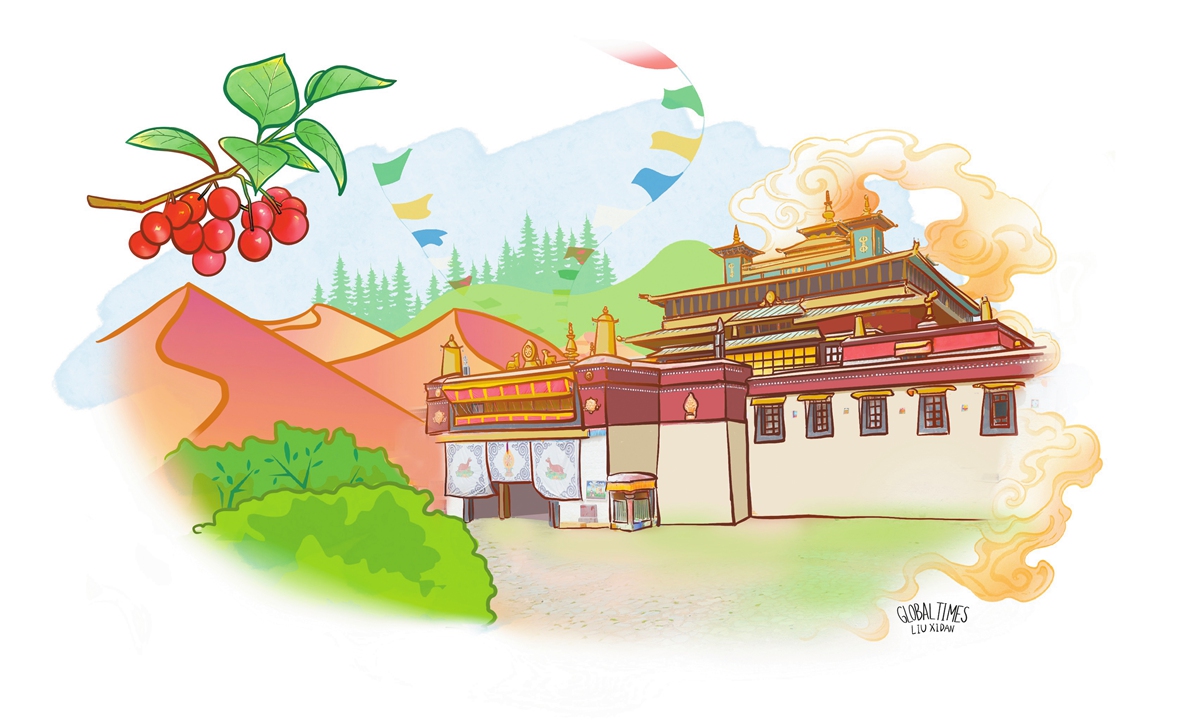
Illustration: Liu Xidan/GT
In Southwest China's Xizang Autonomous Region, along the banks of the Yarlung Zangpo River is a surprisingly vast expanse of desert located within the boundaries of Zhanang county, which is under the jurisdiction of Shannan city.
Due to its geographical location and climatic reasons, Zhanang once faced desertification and soil depletion issues. Once upon a time, the people living here were greatly troubled by the sand. As the landscape leveled out, the river left behind layers of silt and sand along its midsection. Post-monsoon, the water receded, revealing the sediment, which hardened as it dried. Subsequently, the wind swept the sand over farms and thoroughfares, creating migrating dunes.
After years of efforts to control desertification and carry out ecological construction such as building breakwaters, adopting planting techniques suited to the local environment and placing straw lattices on the sandy terrain to stabilize the sand, Zhanang has become a cultural and tourism treasure that blends ancient civilization and desert scenery.
Nestled in Zhanang's Sangye town, the Samye Monastery stands as a testament to the ingenuity of 8th-century architecture.
As Xizang's first monastery, it reflects the intricate principles of Buddhist cosmology. The assembly hall, a fusion of Tibetan, Han and Indian architectural styles, has earned the monastery its alternative name, the Three Style Monastery.
Additionally, it is home to Xizang's first desert park - the Zhanang Sand Dune Art Park - and the most concentrated area of braided river systems on the snowy plateau, a dreamland where nature and art are perfectly integrated.
In this place, you can ride an all-terrain vehicle (ATV) to experience the romance of the lakes and desert on the plateau.
You can sit on a sandboard and speed down from a desert sand dune, fully enjoying the thrill and excitement of sand surfing. You can also listen to the distant and desolate sound of camel bells or ride a camel yourself as you appreciate the sunset on the plateau. Half is desert, with rolling dunes that tell ancient stories; the other half is an oasis, with lush greenery that showcases the new ecological face of the snowy plateau.
Standing on the Yarlung Zangpo River observation deck, the most beautiful perspective of the river unfolds before you. Gazing at the Mountain Habu in the distance, the surging river flows tirelessly, accompanied by the blue sky and white clouds, nourishing this magical land day and night.
With its improved environment, Zhanang is now teeming with tourists who come to enjoy the scenery. Walking beneath the red bricks and white tiles of the Samye Monastery, we can witness the flourishing development of Tibetan culture. The thick walls of Langselin Manor are a witness of the tremendous changes between old and new Xizang.
Have you ever tasted cherries grown at an altitude of 3,500 meters? Xizang has a unique climate and soil, with significant temperature differences between day and night, long hours of sunlight, intense ultraviolet rays, and clean air, which makes the cherries here large, deep in color, and gives them a crisper and sweeter taste.
Zhanang used to be a barren land suffering severe desertification. After multiple surveys of soil and water quality and ecological restoration, the region now grows high-quality cherries.
The desert of the past is now green with grass and lush with trees, and the yellow sand has disappeared.
Zhanang county has shaped tourism with culture and highlighted culture through tourism. Adhering to the path of green development, it has built a highland of sustainable civilization with an increasingly solid ecological security barrier, cultivating the flower of cultural tourism in the Tibetan desert.
The author is a faculty member with the School of Applied Economics, Renmin University of China. life@globaltimes.com.cn




